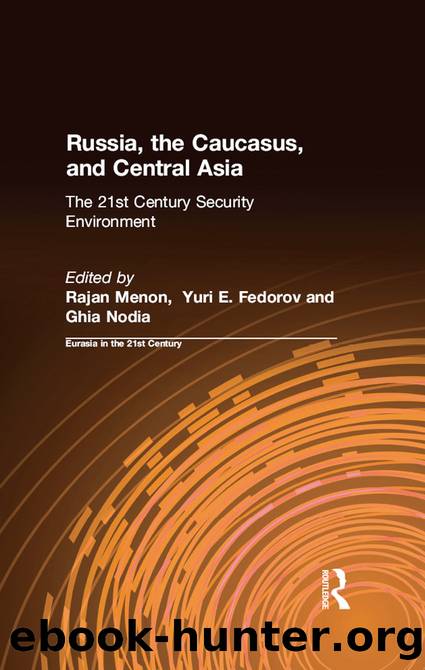Russia, the Caucasus, and Central Asia by unknow

Author:unknow
Language: eng
Format: epub
Tags: Social Science, Women's Studies, Political Science, General
ISBN: 9781315501727
Google: bHqTDAAAQBAJ
Publisher: Routledge
Published: 2016-07-01T13:37:10+00:00
In 1990â91, the output of natural gas in Kazakhstan, Azerbaijan, and Turkmenistan exceeded 100 billion cubic meters a year, about 4 percent of the world production; more than 80 percent of this was extracted in Turkmenistan. However, by the middle of the 1990s it had fallen by half, due predominantly to the drastic cut of production in Turkmenistan caused by a dispute with Gazprom over export quotas and non-payment, as well as by other difficulties due to the collapse of the USSR. In 1997 the production of gas in Turkmenistan was down to about 10 billion cubic meters a yearâthe level of domestic consumptionâas a result of Gazpromâs refusal to transport Turkmenistanâs natural gas via Russian territory, in order to put economic and perhaps political pressure upon Ashkabad. (See Table 4.9.)
The International Gas Union forecasts that by 2030, world natural gas consumption may rise to 3,500â4,000 billion cubic meters a year.17 The exportable gas potential of the Caspian region in the first two decades of the twenty-first century is estimated, at its maximum, to be about 170 billion cubic meters a year. If both of these forecasts are accurate, then the Caspian countries will be able to satisfy 4â5 percent of the world demand for gas. About two-thirds of this potential gas exportâapproximately 120 billion cubic meters a yearâmay be produced by Turkmenistan. However, this is an extremely optimistic prediction, which may be fulfilled only if the transportation problems are settled and significant funds are invested in the local gas industry.
Russian reserves of gas are from 12 to 16 times larger than those of the Caspian region. Russia already exports about 200 billion cubic meters of gas, and its share of world production is somewhere between one third and one quarter. There is every reason to believe that in the coming ten to fifteen years Russia will remain the largest producer and exporter of gas. Iran, too, has much greater gas resources than the newly independent Caspian states: up to 20 trillion cubic meters in gas fields in the southern part of the country. Thus the general outlook is that gas exports from the Caspian countries will play only a secondary role on the world energy market.
However, with some growing regional markets for gas such as southern Europe, the Mediterranean, and Turkey, Caspian countries may edge out Russia because their gas is more competitive than Russiaâs. If so, then Russia will be deprived of a large part of its export earnings, which could be quite painful. To avoid that, Gazprom seems to be trying to direct the eventual flow of Turkmenistanâs gas to South Asia, Pakistan, and India, where Russian gas industry has no serious interests. That could explain, in part, why Gazprom canceled the transportation of gas from Turkmenistan to Europe.
The prospects for development of oil and gas deposits both in the Caspian and in Russia, and hence the results of their eventual competition, vitally depend on the amount of foreign capital that is invested into their energy industries.
Download
This site does not store any files on its server. We only index and link to content provided by other sites. Please contact the content providers to delete copyright contents if any and email us, we'll remove relevant links or contents immediately.
Hit Refresh by Satya Nadella(8854)
When Breath Becomes Air by Paul Kalanithi(8038)
The Girl Without a Voice by Casey Watson(7602)
A Court of Wings and Ruin by Sarah J. Maas(7255)
Do No Harm Stories of Life, Death and Brain Surgery by Henry Marsh(6685)
Shoe Dog by Phil Knight(4887)
Hunger by Roxane Gay(4677)
A Higher Loyalty: Truth, Lies, and Leadership by James Comey(4550)
The Rules Do Not Apply by Ariel Levy(4523)
Everything Happens for a Reason by Kate Bowler(4474)
Tuesdays with Morrie by Mitch Albom(4399)
The Immortal Life of Henrietta Lacks by Rebecca Skloot(4255)
How to Change Your Mind by Michael Pollan(4112)
Millionaire: The Philanderer, Gambler, and Duelist Who Invented Modern Finance by Janet Gleeson(4094)
All Creatures Great and Small by James Herriot(3986)
Tokyo Vice: An American Reporter on the Police Beat in Japan by Jake Adelstein(3861)
Elon Musk by Ashlee Vance(3854)
The Money Culture by Michael Lewis(3846)
Man and His Symbols by Carl Gustav Jung(3845)
